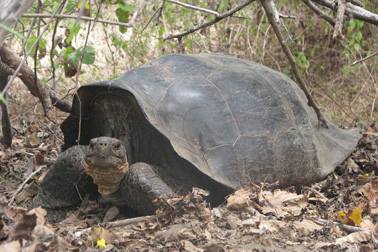
A species of giant tortoise believed extinct for 150 years was actually just moved from its original home and now lives on the volcanic slopes of the northern shore of Isabela Island in the Galapagos archipelago.
A genetic analysis, published in the latest Current Biology, found that DNA footprints of the long lost tortoise species, Chelonoidis elep hantopus, exist in the genomes of its hybrid offspring. These tortoises turn out to be a mix of C. elephantopus and another giant tortoise from the area, C. becki.
While researchers have yet to isolate a purebred C. elephantopus individual, such tortoises must exist, based on the DNA data. The study marks the first time that a species has been rediscovered by way of tracking the genetic footprints left in the genomes of its hybrid offspring.
"This work also underscores the importance of museum collections in facilitating new discoveries," co-author Ryan Garrick told Discovery News. "Here, we were able to extract DNA from tortoise bones that were collected many decades ago, and use this DNA to characterize the gene pool of purebred C. elephantopus."
Garrick is a former Yale postdoctoral researcher who is now an assistant professor at the University of Mississippi.
He and his colleagues visited Volcano Wolf on the northern tip of Isabela Island and took blood samples from more than 1600 tortoises. The scientists then compared them to a genetic database of living and extinct tortoise species.
The matching process detected the genetic signatures of "extinct" C. elephantopus in 84 of the Volcano Wolf tortoises, meaning one of their parents was a purebred member of the missing species.
In 30 cases, breeding took place within the last 15 years. Since the lifespan of the tortoises can exceed 100 years, there''s a high probability that many purebreds are still alive.
The Galapagos tortoises are famous for their influence on Charles Darwin''s ideas about evolution by natural selection. It''s no wonder they captured his attention: individuals can weigh nearly 900 pounds and grow to almost 6 feet in length.
From http://care2.com

